Keeping braces clean
Last time, you read about braces pain relief tips.
Today, we’ll cover our top tips on how to keep your braces clean.
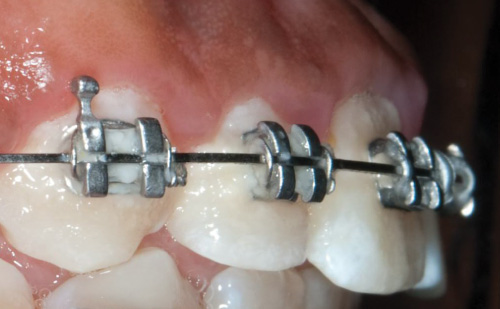
Photo above: Plaque trapped around braces. Note the white fuzz sticking to the teeth above the braces and under the wire. You will want to remove this debris to prevent cavities.
How you take care of your teeth during braces directly affects your final result.
- Arrive at visits with clean teeth. Show us your cleanest teeth because fuzzy plaque and partially digested snacks get in the way of seeing where to move your teeth.
- Drink water. Do not drink soda or juice. (Paglia et al., 2016)
- Eat meals. Do not eat snacks or sugar. (Mahboobi et al., 2021)
- Brush after eating and before bed. A manual brush or power brush can both remove plaque. (Mylonopoulou et al., 2021)
- Floss nightly before brushing. (Shamsoddin, 2022)
- Check plaque removal with a flashlight. Lift the lips to expose the gums. Then look for clean and shiny teeth near the gums and under the wires.
- Visit the dentist during orthodontic treatment. The teeth should be cleaned every 3-6 months. (Chapple et al., 2015)
Cleaning Teeth Normally vs. Cleaning with Braces
The main difference between cleaning your teeth normally and cleaning your teeth with braces is that with braces, there are extra nooks and crannies for food and plaque to hide.
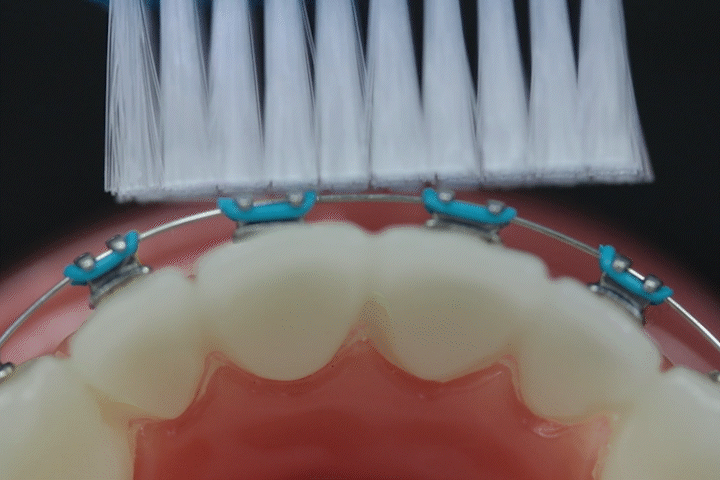
Photo above: the wrong way to brush perpendicular to the braces. The bristles have no chance to reach the plaque on the tooth surface
Our most successful patients have two great habits:
- Clean between the braces and the wire.
- Clean between the teeth.
1. Clean between the braces and the wire
Fortunately, you already own the best toothbrush to clean your braces — an ordinary manual toothbrush works best. A normal manual toothbrush works just as well as a braces specific manual toothbrush (Farook et al., 2023). An ordinary manual toothbrush works just as well as a powered toothbrush (Johal et al., 2023).
Unfortunately, ordinary brushing technique won't get rid of all the trapped gunk between the braces and the gums.
The good news is that a fresh brushing technique is easy! You just brush above and below the braces.
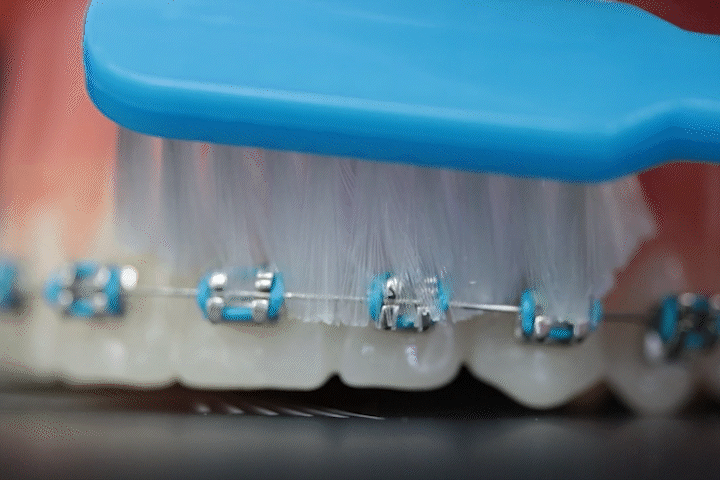
Step 1: Scrub with the bristles angled to clean the tops of the braces. If you are brushing the top teeth, angle the bristles down to brush the top part of the top braces. If you are brushing the bottom teeth, angle the bristles up to clean the bottom of the bottom braces.
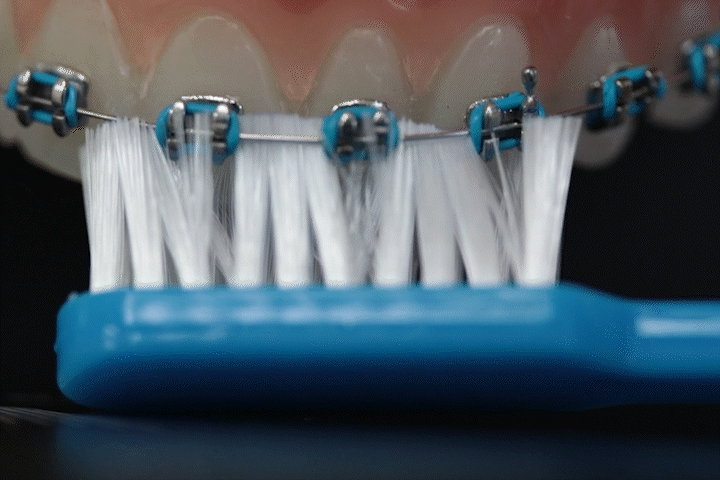
Step 2: Scrub with the bristles angled to clean the bottom of the braces. If you are brushing the top teeth, angle the bristles up to brush the bottom part of the top braces. If you are brushing the bottom teeth, angle the bristles down to clean the tops of the bottom braces.
2. Clean between the teeth
The second tricky area to clean is between the teeth near the gum.
Even after brushing well, our patients notice that there are some zones between the teeth that still look fuzzy. That's when they ask if we have any recommendations for cleaning their braces.
The first recommendation that any orthodontist, dentist or hygienist will make will be to use floss to clean that area nightly.
To make flossing easier, our patients recommend Glide Threader Floss, Oral-B Super-Floss, or Plackers Orthopicks. Just feed the floss under the wire and floss the sides of the teeth - then re-feed the floss for each tooth.
Water flossers are not better. Save your money. (Tyler et al. 2023; Al Harir et al.i, 2023; AlMoharib et al., 2024).
Our patients swear by our second recommendation - especially for after lunch: the portable proxy brush. This “Christmas tree” like pipe-cleaner is designed to get into all the areas your toothbrush has a hard time reaching. It can dislodge debris, but should not be used in place of a tooth brush for removing plaque.
Frequently Asked Questions
What toothbrush should I buy?
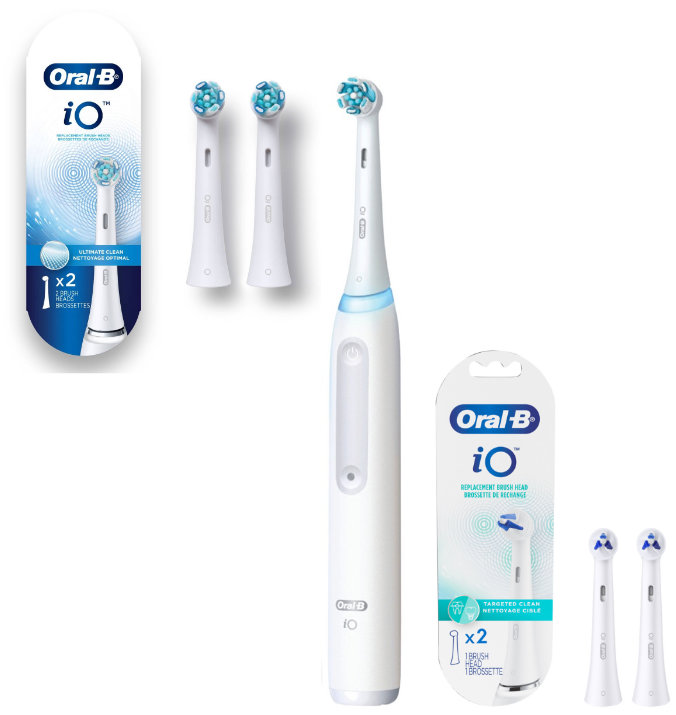
Oral-B iO Series 3 Rechargeable Electric Toothbrush, Oral-B iO Ultimate Clean Replacement Brush Head for most areas, and iO Targeted Clean Replacement Brush Head for trouble spots.
- Oral-B iO Series 3 Rechargeable Electric Toothbrush, Oral-B iO Ultimate Clean Replacement Brush Head for most areas, and iO Targeted Clean Replacement Brush Head for trouble spots.
- Oral-B Pro 1000 Rechargeable Electric Toothbrush, Oral-B Precision Clean X-Filament Replacement Brush Head for most areas, and Oral-B Interproximal Clean Replacement Brush Head for trouble spots.
When should I brush my braces?
Brush after every meal (so that food doesn't linger) and brush before bed.
How long should I brush with braces?
Our patients set a timer for 3 minutes. They use the toothbrush to clean the top, bottom and front of each bracket. Then they look in the mirror to check that everything is clean.
How do I know if the braces are clean enough?
Look in the mirror to see if there is white stuff stuck between the metal and the gum. If there is debris, fuzziness or roughness, then keep brushing :-)
What kind of toothpaste should I use with braces?
Fluoride toothpaste is the best kind of toothpaste to use with braces. We recommend:
- Plaque-HD (watch a video to see how it highlights missed plaque in bright green)
- Crest Pro-Health Toothpaste
- Colgate Cavity Protection Fluoride Toothpaste
- Colgate Prevident 5000 Booster (by prescription only)
How can I keep my breath fresh with braces?
Foul-smelling byproducts of bacteria cause bad breath. To keep your breath fresh, brush after every meal and floss nightly. Please avoid gum (which pulls braces off teeth) and sugary mints (which cause cavities).
Cleaning your tongue daily with a purpose-made tongue scraper or spoon (not a brush) can reduce bad breath. (Pedrazzi et al., 2004)
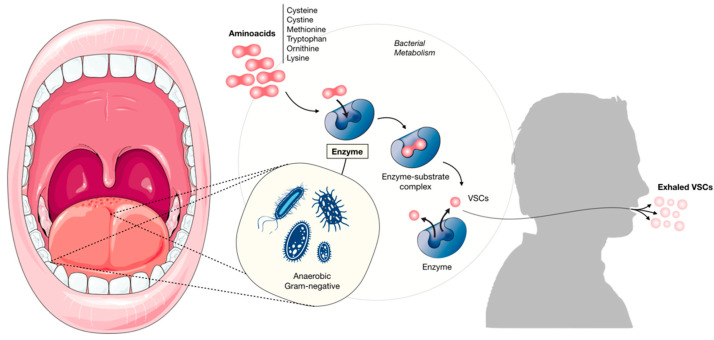
Diagram of how bacteria create bad breath. (Izidoro et al., 2022)
Why floss with braces?
Teeth move quickly and comfortably through healthy gums. Flossing dislodges unhealthy bacteria that sticks to the side of your teeth near your gums.
What about fluoride mouthwash?
Fluoride mouthwash is a great help in preventing cavities. It can help loosen plaque which makes brushing easier. It also helps prevent cavities. Plus, it leaves you with fresher breath! Our patients use a fluoride mouthwash nightly. We recommend:
- ACT Anticavity Fluoride Rinse
- Colgate Phos-Flur Rinse
- Colgate PreviDent Rinse (by prescription only)
Next up, what to do to soothe any irritations on your lips or cheeks.
References
- Paglia, L., Scaglioni, S., Torchia, V., De Cosmi, V., Moretti, M., Marzo, G., & Giuca, M. R. (2016). Familial and dietary risk factors in Early Childhood Caries. European journal of paediatric dentistry, 17(2), 93–99.
- Mahboobi, Z., Pakdaman, A., Yazdani, R., Azadbakht, L., & Montazeri, A. (2021). Dietary free sugar and dental caries in children: A systematic review on longitudinal studies. Health promotion perspectives, 11(3), 271–280.
- Mylonopoulou, I. M., Pepelassi, E., Madianos, P., & Halazonetis, D. J. (2021). A randomized, 3-month, parallel-group clinical trial to compare the efficacy of electric 3-dimensional toothbrushes vs manual toothbrushes in maintaining oral health in patients with fixed orthodontic appliances. American journal of orthodontics and dentofacial orthopedics, 160(5), 648–658.
- Shamsoddin E. (2022). Dental floss as an adjuvant of the toothbrush helps gingival health. Evidence-based dentistry, 23(3), 94–96.
- AlMoharib, H. S., Alqasem, A., Almusfer, G., Aldosari, M. A., & Almadhoon, H. W. (2024). The effectiveness of water jet flossing and interdental flossing for oral hygiene in orthodontic patients with fixed appliances: a randomized clinical trial. BMC oral health, 24(1), 498.
- Chapple, I. L., Van der Weijden, F., Doerfer, C., Herrera, D., Shapira, L., Polak, D., Madianos, P., Louropoulou, A., Machtei, E., Donos, N., Greenwell, H., Van Winkelhoff, A. J., Eren Kuru, B., Arweiler, N.,
- Teughels, W., Aimetti, M., Molina, A., Montero, E., & Graziani, F. (2015). Primary prevention of periodontitis: managing gingivitis. Journal of clinical periodontology, 42 Suppl 16, S71–S76.
- Farook, F. F., Alrumi, A., Aldalaan, K., Ababneh, K., Alshammari, A., Al-Khamees, A. A., & Albalawi, F. (2023). The efficacy of manual toothbrushes in patients with fixed orthodontic appliances: a randomized clinical trial. BMC oral health, 23(1), 315.
- Johal, A., Shagmani, M., Alfuraih, O., & Arad, I. (2023). Long-term comparison of the efficacy of manual versus powered tooth brushing in adolescent orthodontic patients: a single-centre, parallel design randomized clinical trial. European journal of orthodontics, 45(6), 808–817.
- Tyler, D., Kang, J., & Goh, H. H. (2023). Effectiveness of Waterpik® for oral hygiene maintenance in orthodontic fixed appliance patients: A randomized controlled trial. Journal of orthodontics, 50(4), 367–377.
- Al Hariri, M. H., Karkoutly, M., Al Kurdi, S., Alkassar, M., & Bshara, N. (2023). The efficacy of the dental Water Jet, orthodontic, and conventional toothbrushes in plaque removal around orthodontic braces in adolescents: A randomized controlled trial. Clinical and experimental dental research, 9(4), 606–613.
- AlMoharib, H. S., Alqasem, A., Almusfer, G., Aldosari, M. A., & Almadhoon, H. W. (2024). The effectiveness of water jet flossing and interdental flossing for oral hygiene in orthodontic patients with fixed appliances: a randomized clinical trial. BMC oral health, 24(1), 498.
- Pedrazzi, V., Sato, S., de Mattos, M.daG., Lara, E. H., & Panzeri, H. (2004). Tongue-cleaning methods: a comparative clinical trial employing a toothbrush and a tongue scraper. Journal of periodontology, 75(7), 1009–1012. https://doi.org/10.1902/jop.2004.75.7.1009.
- Izidoro, C., Botelho, J., Machado, V., Reis, A. M., Proença, L., Alves, R. C., & Mendes, J. J. (2022). Revisiting Standard and Novel Therapeutic Approaches in Halitosis: A Review. International journal of environmental research and public health, 19(18), 11303. https://doi.org/10.3390/ijerph191811303